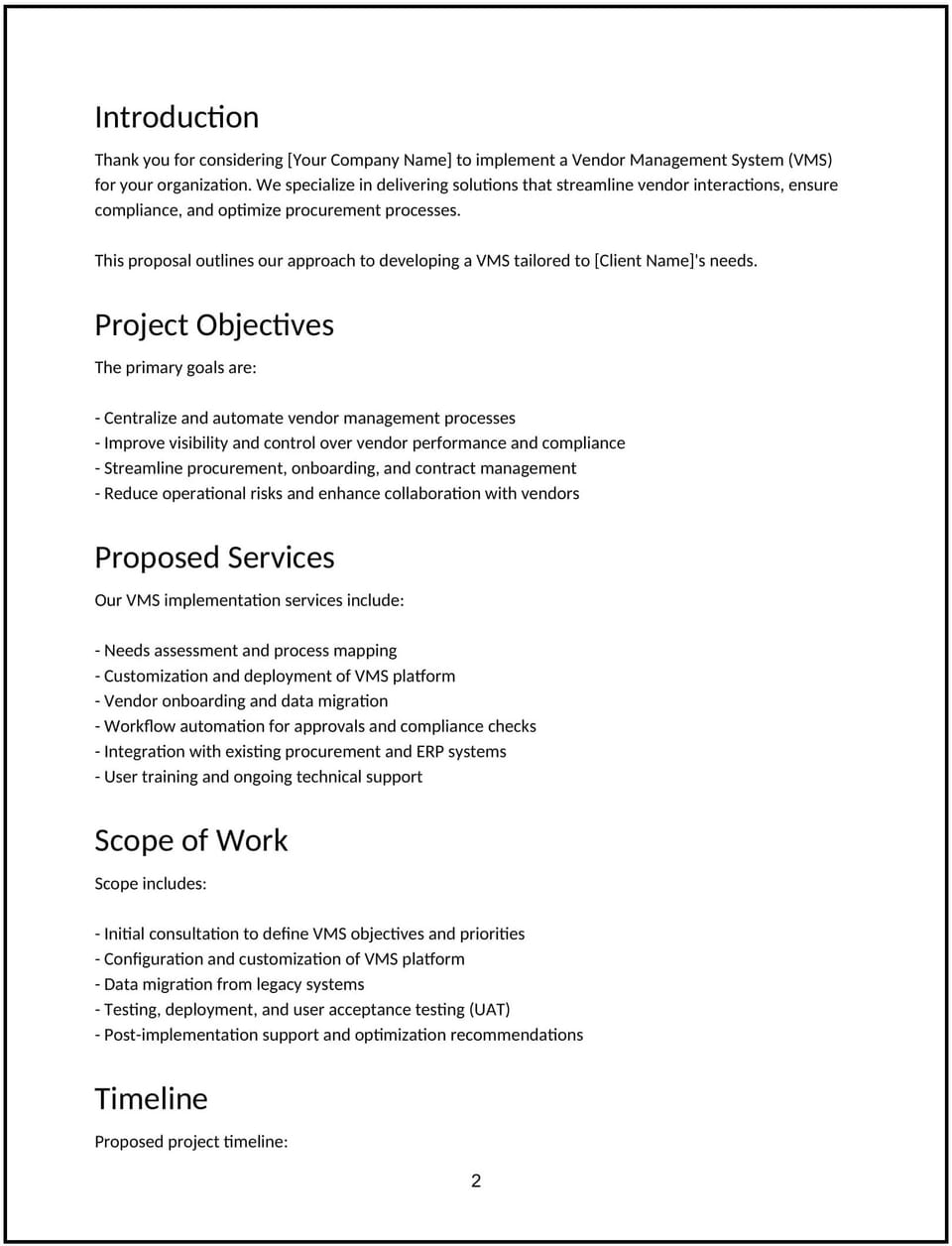Vendor management system proposal: Free template

Customize this free vendor management system proposal with Cobrief
Open this free vendor management system (VMS) proposal in Cobrief and start editing it instantly using AI. You can adjust the tone, structure, and content based on your client’s size, procurement volume, and industry. You can also use AI to review your draft — clarify scope, tighten language, and highlight value before sending.
Once you're done, send, download, or save the proposal in one click — no formatting or setup required.
This template is fully customizable and built for real-world use — ideal for companies seeking to streamline vendor onboarding, tracking, compliance, and performance. Whether you’re offering software implementation or a full process overhaul, this proposal helps you present your solution clearly and close work faster.
What is a vendor management system proposal?
A vendor management system proposal outlines how you’ll help a client set up or improve the tools and processes used to manage third-party vendors. It includes your recommended solution (software or framework), implementation steps, deliverables, and pricing.
This type of proposal is used by procurement consultants, IT advisors, legal teams, and operations professionals working with growing or regulated businesses. It often precedes implementation of new systems for vendor selection, risk assessment, contract tracking, and ongoing performance evaluation.
Unlike a general procurement or sourcing proposal, this one is focused specifically on centralizing and optimizing vendor management processes.
Why use Cobrief to edit your proposal
- Edit the full proposal instantly: No reformatting or uploading — just open and tailor the content.
- Use AI to match your approach: Customize for vendor risk, supply chain size, compliance needs, or software stack.
- Run an AI-powered review: Catch vague implementation steps, missing deliverables, or unclear timelines.
- Apply edits in one click: Accept suggested changes section-by-section or all at once.
- Save, send, or download: Export a clean, professional PDF instantly.
When to use this proposal
- When implementing a new vendor management system (VMS) platform for a growing company
- When replacing outdated manual or spreadsheet-based vendor processes
- When responding to compliance gaps, procurement delays, or audit requirements
- When offering software setup, policy creation, and vendor onboarding as a bundled service
- When supporting procurement, legal, or finance teams with third-party risk and contract visibility
What to include in a vendor management system proposal
- Project overview: Explain the goal — such as improving vendor oversight, reducing risk, or creating a centralized platform for third-party management. Tailor this based on the client’s current process challenges.
- Scope of work: List what’s included — such as VMS tool selection or configuration, vendor intake workflows, contract tracking, compliance document collection, performance reviews, and optional integrations (e.g., ERP, accounting tools).
- Timeline: Provide a project schedule — from discovery and system setup to user testing, rollout, and support. Include key milestones like workflow approval or stakeholder onboarding.
- Deliverables: Specify what the client will receive — such as a fully configured VMS, documentation, training materials, onboarding forms, reporting dashboards, and optional playbooks.
- Pricing: Show your pricing structure — fixed project fee, platform licensing, or phased implementation costs. Clarify what’s included and whether ongoing support or license management is separate.
- Call to action / next steps: End with a clear prompt — approve the proposal, schedule a kickoff meeting, or confirm access to existing systems. Keep the next step simple and direct.
How to write an effective vendor management system proposal
- Focus on pain points: Show how your system addresses visibility gaps, approval delays, or risk blind spots.
- Make it operational: Emphasize workflows, automation, and audit-readiness — not just software features.
- Tailor to the client’s stack: Show how your system complements their existing finance, legal, or procurement tools.
- Clarify implementation phases: Break your rollout into manageable steps to ease internal approval.
- Highlight results: Mention expected outcomes like faster onboarding, cleaner data, or better vendor performance tracking.
- End with clarity: Always close with a clear CTA and project-ready confidence.
Frequently asked questions (FAQs)
What types of businesses need a vendor management system?
Any business that works with multiple vendors, especially in regulated, high-growth, or procurement-heavy environments — including tech, manufacturing, retail, healthcare, and finance.
Can this proposal include vendor risk assessments?
Yes — you can include custom intake forms, scoring models, or compliance requirements as part of the scope.
Does this proposal cover software licensing?
It can — just clarify whether you’re recommending an existing VMS platform, implementing a tool the client already uses, or building a lightweight internal system.
Can the system integrate with other tools?
Absolutely. VMS tools can often integrate with ERP, legal, and finance platforms — just include integration scope and testing in your timeline.
Is this proposal a binding agreement?
No — it outlines your services and pricing. A formal contract or statement of work should follow if the proposal is approved.
This article contains general legal information and does not contain legal advice. Cobrief is not a law firm or a substitute for an attorney or law firm. The law is complex and changes often. For legal advice, please ask a lawyer.